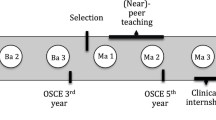Abstract
At our medical college many students have lower ratings in their clinical performance once they start their clinical years (third year). This is contrary to their results in other written exams. Some students demonstrate better clinical performance. We used the six-step Positive Deviance (PD) Conceptual Framework to identify and disseminate the strategies employed by the successful students to improve group clinical performance. Fifty 3rd year students (of a 5-year MBBS program) rotating through internal medicine were assessed mid-rotation with mini-CEX and 360° evaluations. Twenty students (40%) who performed well were invited for in depth interviews in order to identify positive deviant behavior in their clinical skills learning practices. The seven students (14%) who reported novel behaviors were asked to develop strategies for dissemination of their learning behavior in their peers. They decided to work in small groups with their peers, using the identified PD behaviors to encourage learning of history taking and examining skills in their peers. Group performance was assessed at the end of rotation, using mini-CEX and 360° evaluation in comparison to a subsequent group of students in the same year that did not work in PD peer learning groups. For the 360° evaluation the EP2 (generalizability coefficient) was 0.92 and for the mini-CEX the EP2 was 0.95, taking into account the variances between participants, groups, time and the interactions effects; thus indicating good reliability of both the assessment methods. A statistically significant difference (p < 0.05) was seen for improvement in medical interviewing skills and clinical judgment on the mini-CEX exam and 360 evaluation (p < 0.0001) in the PD group. Positive Deviance approach can help highlight behaviors among medical students, which contribute to success but may go unnoticed. Learning strategies based on the PD framework can improve student’s group performance.
Similar content being viewed by others
References
Tufts University. (2010). www.positivedeviance.org. Online; cited 5 January, 2010, Available from: HYPERLINK www.positivedeviance.org/projects.
American Board of Internal Medicine. (2010). Online cited 3 April, 2010, Available from: HYPERLINK http://www.abim.org/pdf/paper-tools/Resident.pdf.
Dearden, K., Quan, L., Do, M., Marsh, D., Schroeder, D., Pachon, H., et al. (2002). What influences health behavior? Learning from caregivers of young children in Viet Nam. Food and Nutrition Bulletin, 23(4), 117–127.
Friedman S. R., & Gelabert M. P. (2008). Positive deviance control-case history: A method to develop grounded hypotheses about successful long-term avoidance of infection. BMC Public Health, 8(94).
Kevin, E. W. (2010). Reading means more than deciphering the words on the page. Medical Education, 44(4), 330–332.
Lapping, K., Schroeder, D., Marsh, D., Albalak, R., & Jabarkhil, M. (2002). Comparison of a positive deviant inquiry with a case-control study to identify factors associated with nutrition status among Afghan refugee children in Pakistan. Food and Nutrition Bulletin, 23(4), 26–33.
Lindberg, C., Norstrand, P., Munger, M., DeMarsico, C., & Buscell, P. (2009). Letting go, gaining control: Positive deviance and MRSA prevention. Clinical Leader, 2(2), 60–67.
Mackintosh, U., Marsh, D., & Schroeder, D. (2002). Sustained positive deviant child care practices and their effects on child growth in Viet Nam. Food Nutrition Bulletin, 23(4), 16–25.
Marra, A., Guastelli, L., & De Arau′jo, C. P. (2010). Positive deviance: A new strategy for improving hand hygiene compliance. Infection Control Hospital Ep, 31(1), 12–20.
Marsh, D. R., Schroeder, D. G., Dearden, K. A., Sternin, J., & Sternin, M. (2004). The power of positive deviance. BMJ, 329(7475), 1177–1179.
Martin, I. G., Stark, P., & Jolly, B. (2001). Benefiting from clinical experience: The influence of learning style and clinical experience on performance in an undergraduate objective structured clinical examination. Medical Education ASME, 34(7), 530–534.
Masterson, J. M., & Swanson, J. H. (2000). Female genital cutting: Breaking the silence, enabling change (p. 5). Washington, DC: International Center for Research on Women and the Center for Development and Population Activities.
McNamara, D. S. (2010). Strategies to read and learn: Overcoming learning by consumption. Medical Education, 44, 340–346.
Royal College of General practitioners. (2005-2006) Multi-Source Feedback. Retrieved from http://www.rcgp-curriculum.org.uk/mrcgp/wpba/multi-source_feedback.aspx/
Sparks, D. (2006). Leading for results: Transforming teaching, learning, and relationships in schools (Amplify positive deviance in schools) (2nd ed.). SAGE publications.
Spreitzer, G., & Sonenshein, S. (2004). Toward the construct definition of positive deviance. American Behavioral Scientist, 47(6), 828–847.
Stephenson, D. (2010). The leeds teaching hospitals NHS trust. Online; cited 4 April, 2010, [360 Analysis/form]. Available from: HYPERLINK www.leeds.ac.uk/medicine/meu/clinteach06/Dawn_Stephenson.ppt.
Sternin, J. (2003). The change champion’s fieldguide. In L. Carter, D. Ulrich & M. Goldsmith (Eds). Best Practice Publications.
Sternin, J., & Pascale, R. (2005). Your company’s secret change agents. Harvard Business Review.
Sternin, M., Sternin, J., Marsh, D. (1998). Designing a community based nutrition program using the hearth model and the positive deviance approach—a field guide. Save the children.
Zeitlin, M., Ghassemi, H., & Mansour, M. (1990). Positive deviance in child nutrition—with emphasis on psychosocial and behavioral aspects and implications for development (1st ed.). Tokyo: United Nations University Press.
Acknowledgments
Dr. Lubna Baig, University of Calgary, Canada for her help with the generalizability analysis.
Author information
Authors and Affiliations
Corresponding author
Rights and permissions
About this article
Cite this article
Zaidi, Z., Jaffery, T., Shahid, A. et al. Change in action: using positive deviance to improve student clinical performance. Adv in Health Sci Educ 17, 95–105 (2012). https://doi.org/10.1007/s10459-011-9301-8
Received:
Accepted:
Published:
Issue Date:
DOI: https://doi.org/10.1007/s10459-011-9301-8




